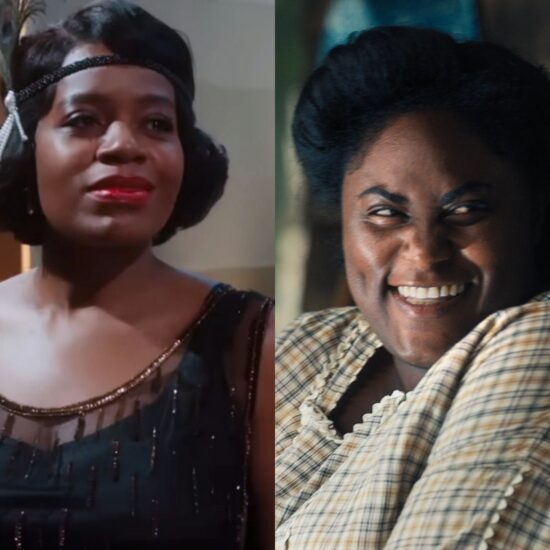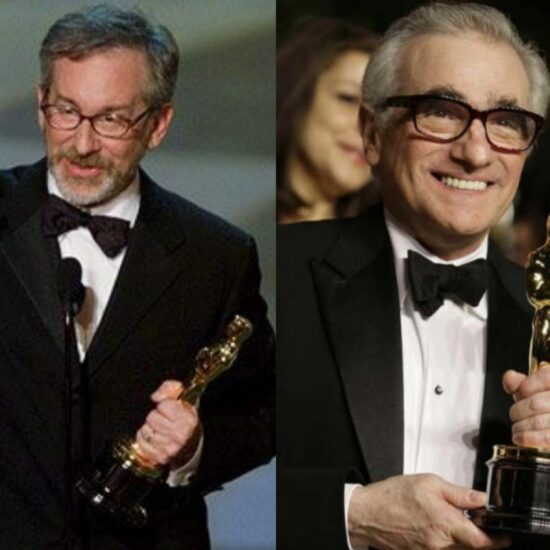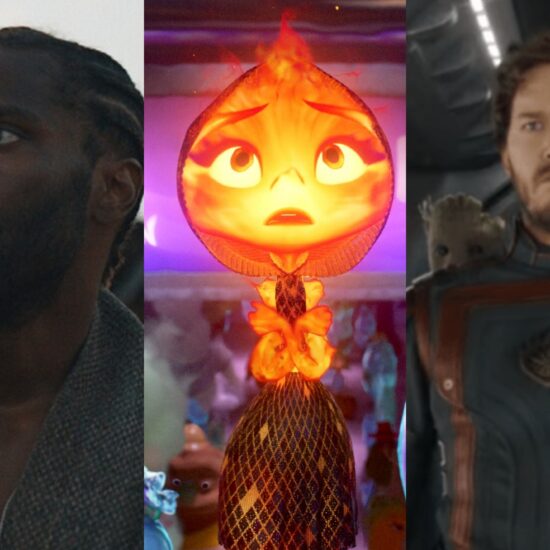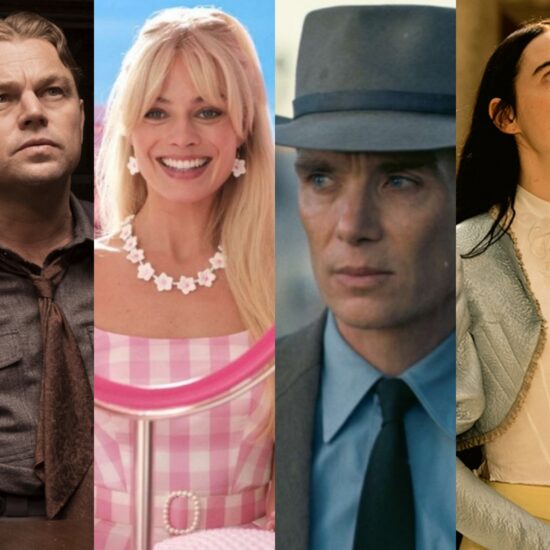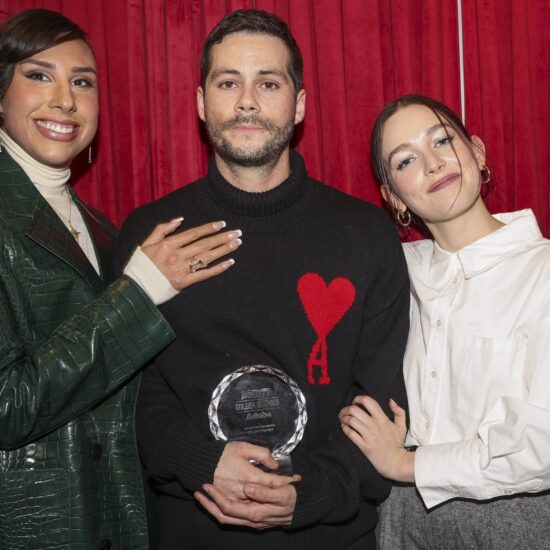
[This story contains major spoilers from the Upload season three premiere “Ticking Clock” and second episode “Strawberry.”]
In the season three return of Greg Daniels‘ genre-mashup Upload, a dangerous voter suppression plot begins to unfurl.
For those who haven’t been consistently following the Prime Video series, that story element alone would seem confusing. The sci-fi comedy stars Robbie Amell as computer programmer Nathan Brown, whose consciousness is uploaded into a virtual afterlife called Lakeview by his girlfriend Ingrid Kannerman (Allegra Edwards). But once there, he begins to develop feelings for Nora Antony (Andy Allo), his “Angel” — a living, breathing personal afterlife assistant who works for Lakeview’s parent company, Horizon.
For two seasons, the show primarily existed as a rom-com that juggled big issues like classism, the growing impact of AI and VR, and what it means to be “alive.” It was funny and heartfelt, but also smart and unnervingly timely. It has remained all of that (particularly the timely part), but with one major plot development for season three: The end of season two introduced a major voter suppression effort by one of Nathan’s Lakeview neighbors, billionaire David Choak (William Davis), who in name seemingly alludes to a set of real-life plutocrat siblings.
Choak and a group of other highly wealthy and equally influential power players had Nathan murdered and stole his code to create Freeyond, a version of Horizon’s Lakeview, but affordable for lower income people. With it, they plan to bait and switch millions, promising a digital afterlife but actually taking their (literal) heads and leaving them on cartridges, where they’ll be unable to vote.
Season three of Upload picks up in the midst of this, with Nathan downloaded back into his human body and racing against the clock with Nora and a group of activists called Ludds — they support dying naturally and are against the concept of uploading — to stop Choak’s plot.
“The opening of season three had to wrap up the cliffhangers of season two and also launch us into our new storylines,” episodes one and two director Jeff Blitz tells The Hollywood Reporter. “Nathan is back in the real world, finally ready to explore his relationship with Nora, even as they both grapple with the bigger conspiracy of Freeyond and the ticking time bomb that is Nathan’s actual head.
“Simultaneously, Ingrid is ready for a much-needed life makeover when she discovers there’s a way for her to step back into the life she had going before and try again,” he continues. “Also, there’s the mystery of what the sinister cabal is up to and whether our heroes stand a chance of succeeding or even surviving.”
For the Upload season three premiere, Blitz spoke to THR about juggling those plot lines, making a head explode, working with Amell on playing two versions of Nathan, and capturing the hilarity and horrors of advancing tech in Lakeview and the real world.
This is the first time Robbie is playing two versions of Nathan. How did you both approach personifying them similarly and differently? Were there any challenges around him pulling double-duty?
We made choices with Robbie about ways to help signal whether he was playing “Nathan” or “Back-Up.” Some of these were physical, like subtle changes to his appearance, but many were unspoken choices Robbie would make in posture, gesture, ways of speaking. This was double-duty for Robbie, asking him to keep straight where each version of Nathan is on his specific journey. Later in the season, the costume changes get increasingly challenging.
We finally see Nora and Nathan get to be an “in-real-life” couple, while Ingrid is back in the hug suit in Lakeview trying to be more honest — despite also trying to make herself into Nora. How did you think about defining and differentiating these couples who feel like they’re on parallel journeys of discovery right now?
We talked a lot about the fun of shows that let us see hero couples change as their circumstances do. Before they’re in the real world together, Nathan and Nora have a dreamy idea of what they’d be like as an actual couple. But once they’re actually here, there’s all sorts of surprises for them. In episode two, they’re visiting a long-married couple, and they’re asked basic questions about their wishes for the future — and discover suddenly there’s lots they’ve never talked through and maybe aren’t even on the same page about. We get to be a fly on the wall as they navigate the real stuff of relationships — even set against a backdrop of a frightening and glitchy future. There’s a similar thing that happens with Ingrid and Back-Up, even though it’s in a weirder key, set in Lakeview and hammed up with all of Ingrid’s melodrama. Even so, it’s fundamentally the story of people figuring out how to be vulnerable and real with the person they love.
The last time we saw a downloaded person’s head explode, it was from a distance, but you kick off the season by recreating the experience up close. How did you execute that both in terms of VFX and your cast?
If you’re ever asked if it’s easy to make someone’s head explode on TV, trust me when I tell you the answer is “no,” and also that it’s absolutely worth every meeting you’ll have to discuss the extent of blood splatter — whether to build a VFX neck flap and which explosive take to put the series lead in for. Basically, as in all things Upload, we came from a character place first: Here’s a scene about Nora and Nathan connecting as they’ve wanted to connect since early on. We need to feel the reality of that connection, to imagine it’s the beginnings of a scene that will develop in a romantic, intimate way — only to have it end abruptly and horribly. How we shoot it, how they perform it, it’s all in service of that emotion. And the twist to the scene isn’t just shock value — though anytime you’re talking neck flap, let’s be honest, it’s not not that — but also succinctly setting up a major tension of the season: Will the long-awaited development of Nathan and Nora’s love be interrupted by the bloody realities of the world?
For episode two, you had the nightmarish yet comedic storyline of Upload’s version of factory farming. What exactly was coming out of that “cow,” and how did you navigate delivering that concept with the Upload team?
We discussed holding a contest for Future Farmers of America to see how quickly some kid could genetically create the Cowenstein Monster that cameos in episode two, but decided instead to use an old-fashioned mix of fantastic VFX from Eddie Anton, brilliant production design from Rachel O’Toole and cinematography from Simon Chapman, and truly horrific, cottage cheese-based SFX from Jak Osmond. No cows were harmed or even used during the filming of that scene. (I cannot speak to potential harm to any viewer’s psyche.)
We see several versions of AI Guy struggling to grasp basic human experiences, but we also see AI hairdresser who has a distinctive, more competent personality. How did you work with Owen Daniels on crafting those various AI guys, and how do you explain the hairdresser navigating human interaction better than the AI guys in training with Aleesha (Zainab Johnson)?
Because Owen is one of the show’s writers, he comes to each scene already with a very clear take on the story of AI Guy in that scene. And then his gift for unexpected comedy choices just elevates everything. As a director, my role is to create space for someone with that kind of aptitude for endless play and discovery. Just hold space and let him go. As for AI Hairdresser’s navigation of human interaction, as we see with real world AI skimming for human stuff to copy, the Lakeview AI program has a wealth of data from juiced-up portrayals of hairdressers to draw from and that’s what we see in AI Guy’s salon-inspired chitchat. But it’s all empty, really. It’s when AI Guy is taken out of a skimmable context and asked to try to think and feel for itself — to self-reflect — that things get dicey.
Luke tries to forget Nathan and Aleesha in episode two by wiping them from his memories and replacing them with Dragon Tales. The entire sequence is really silly, but Kevin Bigley really captures the emotions of abandonment and the desperation of wanting to move on. Did you want to play that scene funnier or more emotional for Luke?
The facts of the dressing of the scene are dark and weird, but the emotion is relatable: A former soldier who, in his afterlife, is so distraught at missing his best pal that he tries to wipe his memories clean. For me, the comedy comes from when you play a scene like that for its emotional truth. It’s all about heart, and Kevin and Zainab knew that instinctively. We can all connect to the feeling of missing a best friend. Setting in a memory parlor of the future, using a critique of Dragon Tales to goose the comedy, all of that just serves to make the emotion of it that much more unexpected when it pokes through. Aleesha sees it first: Luke is a big baby, but she loves the guy and empathizes, and hopefully we do too.
The first two episodes of Upload season three are currently streaming on Prime Video.
Interview edited for length and clarity.









